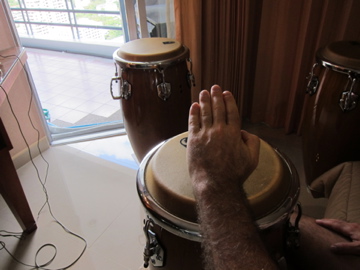My first drum teacher used to chant repeatedly, “minimum input maximum out put” when it came to the topic of playing techniques and how to hit the drum. It was true over 30 years ago and it is still true now. What he was talking about is that it is not important how hard you hit the drum but it is about the technique you use. You do not have to be big and strong ot even young or athletic. It is all about technique. Moreover, not wasting movement, using the bodies own structure and weight and some other interesting concepts dealing with movement. When we compare hitting a drum to hitting a baseball with a bat we see that they both have or use the concept of “follow through”. You do not stop when you swing a bat once you make contact with the ball. YOur swing continues even though you have made contact. The same holds true for the drum. When you make contact with the skin you do not stop your motion. Instead you allow your hand to bounce back upwards. This creates one smooth motion instead of two. (Two being hit the drum, rest your hand, lift your hand).

Almost everyone in my drum classes that has not studied with me before stops (and rests their hands on the skin) when they hit the drum. Then they use a 2nd motion to lift there hand back up. They are using 2 motions instead of the one motion that a bounce or arc makes. If you imagine yourslef going through the skin when you hit it then your hand, it will actualy bounce back up. I am not suggesting you hit the drum as hard as you can or hurt your hand by hitting the skin. I am teeling you to let the downward force of gravity drop your hand and when you make contact let that wieght bounce your hand back up, llike a drum stick would. It is a natural relaxed movement. but it does take training and practice to perfect it. Once you have it you will be surprised how much easier it is to play your drum be it conga or djembe .
An exercise I give everyone and you can try right now is to lift your left hand off the drumand hold it about a foot in the air. It does not move, it is going to stay there in the air. Now take your right hand and bring it to the same level. So now both hands are in the air next to each other one foot off of the drum. Now keeping your left hand in the air and not moving it at all drop your right hand and make a tone sound. Watch how far your right hand comes back up to your left. It only came part way. I am sure. Even after reading this article you still naturaly do not rebound the same amount that you put into it. Now as an exercise. Do the same thing, but force your right hand back up to meet your left. At first it will be jerky, two motions. As you work with this exercise, work towards getting the right hand to bounce naturaly up to meet your left hand. So now the same amount of space and time dropping your right hand hand goes into getting your hand to bounce back up. In order for it to do so in one motion it has to bounce.
Now we are not going to play like this as it is not natural. It is too big of a movement and this is an exercise. But if you make tones on the drum now you will notice a new more fluent , relaxed and freer movement. Your hands will feel lighter and you will also be able to play faster as well. Check it out and get back to me with your results. As I mentioned, you can use this technique of bouncing your hand in any type of drumming or percussion. It is all about technique.

